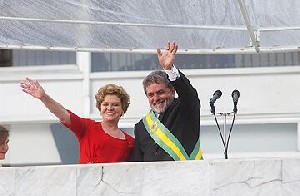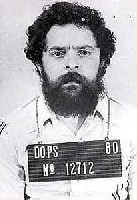Below, advertising
|
President Lula - biography
Luiz Inácio da Silva was born on 27 October 1945 at Garanhuns, in the hinterland of Pernambuco State. Later on, as admitted by Brazilian legislation in the cases where a person becomes better known by a nickname than the real name, he added "Lula" to his name of birth. The name Lula, in Portuguese, means squid (the marine animal), but is also the nickname of many people called "Luiz". Lula is the seventh of the eight children born to Aristides Inácio da Silva and Eurídice Ferreira de Mello.
 In December 1952, the family traveled 13 days on the back of a truck (“pau-de arara”) and settled in Vicente de Carvalho, a poor neighborhood of the city of Guarujá, in São Paulo State. Lula received basic schooling at the Marcílio Dias Public School. In 1956, the family moved into a bedroom at the back of a bar in the Ipiranga neighborhood.
In December 1952, the family traveled 13 days on the back of a truck (“pau-de arara”) and settled in Vicente de Carvalho, a poor neighborhood of the city of Guarujá, in São Paulo State. Lula received basic schooling at the Marcílio Dias Public School. In 1956, the family moved into a bedroom at the back of a bar in the Ipiranga neighborhood.
At age 12, he landed his first job at a local cleaners. Later he became a shoeshine and an office boy. At 14 he got his first fixed employment at a warehouse. He later transferred to a metal parts factory and got a placement in a lathe worker-training course offered by the National Service of Industry - SENAI, a training scheme for industrial workers funded by the public and private sectors. After a three-year course, Lula graduated as a metal worker.
In the strife that followed the 1964 military coup, Lula worked in various factories before joining the Villares Industries, one of the major metal works in the country. It was located in São Bernando do Campo, in the ABC region (ABC is an acronym of the three large cities which compose that industrial cluster: Santo André, São Bernardo and São Caetano), the industrial heartland of São Paulo State. There, his brother José Ferreira da Silva, better known as Frei Chico, brought him into contact with the labor movement.
In 1969, Lula sought a seat on the council of the Metalworkers Union of São Bernardo do Campo and Diadema. In 1972, he was elected first secretary.In 1975, he became president of the 100 thousand-strong union with 92% of the votes. It was at this time that Lula gave a new direction to the Brazilian labor movement. In 1978, Lula was reelected union president and there soon followed the first work stoppages in 10 years since a government-sponsored clampdown on union activities.

Lula and wife Marisa
In March 1979, 170 thousand metalworkers paralyzed the ABC region. Under his charismatic leadership, memorable meetings were held in the local stadium (in Vila Euclides) in defiance of police intimation. Repression against striking workers amidst almost absolute absence of political representation of worker rights in the National Congress led Lula to first consider creating a workers party.
At this time, Brazil was undergoing a gradual process of political decompression under the reins of the Armed Forces, then holding power. On February 10 1980, Lula founded the Workers Party (Partido dos Trabalhadores - PT) together with other union members, intellectuals, politicians and representatives of social movements, such as rural and religious leaders.
In the same year, a new strike by metalworkers led to government intervention in the union and to the imprisonment of Lula and other union leaders, as authorized by the (now derrogated) National Security Law. They were held for 31 days, during which his mother died (Lula was allowed to attend the funerals).
 Lula´s mug shot
By 1982, the PT had been established throughout almost the entire country. Lula guided the Party’s organization and ran in the São Paulo State gubernatorial elections, having come forth. In August 1983, he took part in the setting up of United Workers’ Federation (Central Única dos Trabalhadores - CUT ).
In 1984, he was one of the leading lights of the “diretas-já” campaign in favor of free elections for President. In 1986, he was elected with the largest number of votes (650.134) of any congressman to the parliamentary assembly charged with writing a new constitution for the country.
The PT slated Lula for the presidential elections of 1989, the first one in 29 years. He lost in the second round by a slim margin, and two years later championed the national campaign against corruption that led to the impeachment of President Fernando Collor de Mello.
In 1994 and 1998, Lula was again a candidate, having lost both times to Fernando Henrique Cardoso, who channeled the fears of change of a significant section of the electorate.
In the last week of June 2002, the PT’s National Convention agreed to a wide ranging political alliance with other political parties (PL, PcdoB, PCB and PMN)under a platform of social inclusion for the great majority of the Brazilian people. The vice-presidential candidate on Lula’s ticket was Senator José Alencar, of the Liberal party (PL), from Minas Gerais State.
On 27th October 2002, at the age of 57, Luiz Inácio Lula da Silva was elected President of the Federative Republic of Brazil with almost 53 million votes.
Back to Top
|
|



 In December 1952, the family traveled 13 days on the back of a truck (“pau-de arara”) and settled in Vicente de Carvalho, a poor neighborhood of the city of Guarujá, in
In December 1952, the family traveled 13 days on the back of a truck (“pau-de arara”) and settled in Vicente de Carvalho, a poor neighborhood of the city of Guarujá, in